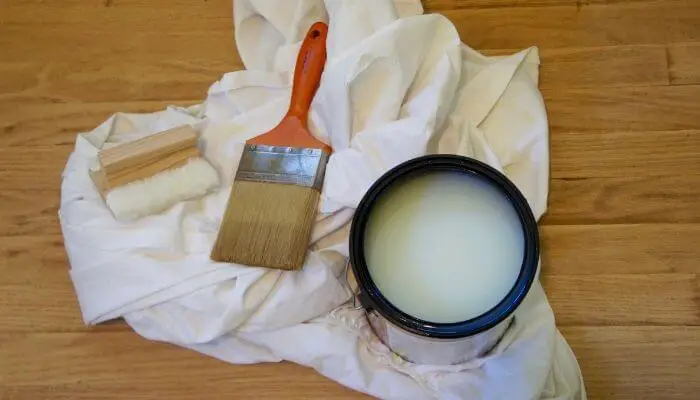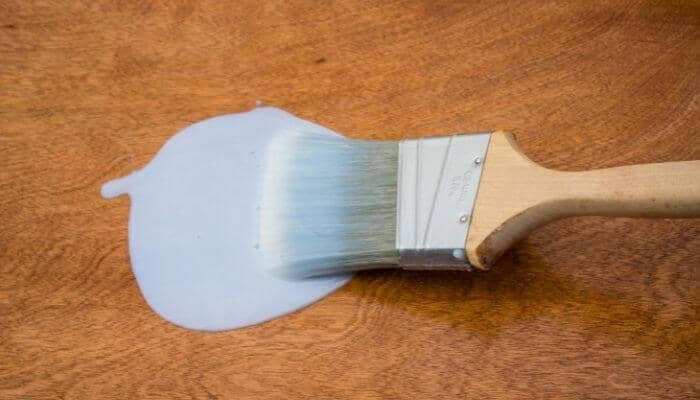Polyurethane is an excellent wood sealant but does it make wood waterproof?
No, polyurethane does not make wood waterproof.
Polyurethane is, however, effective in protecting the wood by making it water-resistant.

It prevents the wood from absorbing water by repelling it.
Applying Polyurethane to your wood, although not completely waterproofing it, does add a layer of protection to it.
This protective coating will increase the durability of your wood as it forms a plastic-like coating over it.
Does Polyurethane Become Less Waterproof Over Time?
There are a few things that affect the durability of a Polyurethane coating. The first thing to note is that Polyurethane is a thin layer.
It is not effective if applied in just one layer as it is discontinuous and has very small holes.
For the best coating, it is recommended that you apply at least three layers of Polyurethane.
With multiple layers, the coating becomes thicker and more cohesive making the overall protection of your wood greater and longer-lasting.
Despite the number of layers, however, Polyurethane is susceptible to scratches and abrasions. It wears down by natural abrasions, even by simply walking on it.

This is the next thing to note as, over time, the overall effectiveness of it fades with the increase of scratches and abrasions.
Next, the natural expansion and contracting of wood will inevitably affect the Polyurethane seal by penetrating it.
And lastly, the coating you add to your wood is not on all four sides of it.
Typically, you only coat the exposed potion of wood, leaving the sides and the underside free and uncoated.
Naturally, over time, water is bound to eventually penetrate the wood and be absorbed, likely from the sides.
This is especially true if you have standing water on the Polyurethaned surface.
Therefore, all things considered, Polyurethane does become less effective over time.
It is susceptible to natural abrasions as well as penetration due to the expansion on contracting of the wood.
It also does not typically coat all four sides of the wood, leaving room for water absorption over time.
It is recommended that you buff and recoat the Polyurethane coating regularly.
Depending on the traffic the area of coated wood sees, buffing and recoating should be done once every three to five years.
Buffing and recoating regularly is a sure way to expand the life of your wood. This is because it keeps the protective seal, sealed!
How To Waterproof Wood Using Polyurethane:
Whilst Polyurethane does not completely waterproof wood, it does add a needed layer of protection.
If you are keen to make sure that your wood is 100% waterproof then some of these articles may help:
A Polyurethane coating increases the durability of wood, essentially giving it a longer lifespan.
Here is how to improve your wood’s water resistance using Polyurethane:
1. Sand the Surface
It is recommended that you start with 100-grit sandpaper, followed by 150-grit, and finish with 220-grit sandpaper.
The first thing you will need to do is prepare your wood for the Polyurethane.
To do this, you will need to sand the surface of the wood. Sanding the wood removes any imperfections such as scratches.
2. Remove the Dust
Once you have sanded the wood and removed all the blemishes, it is time to remove the dust.
For best results, remove most of the dust by vacuuming it up.
It is recommended that you use a soft brush attachment for the vacuum. Follow up the vacuuming with a wipe down.
Make use of a clean, lint-free cloth to wipe away any excess dust. The cloth can be moistened with mineral spirits if necessary.
3. Seal the Surface
Note: Some types of stains are self-sealing. Check the tin of your stain for this information.
If the type of stain you have is self-sealing, this step can be skipped.
Next, oil-based Polyurethane should be thinned.
To thin your Polyurethane, use two parts of the oil-based Polyurethane and one part of mineral spirits.
It is recommended that you pour the two products into a glass container and stir the mixture gently using a flat stir stick.
Note: Never shake a can of Polyurethane! Shaking Polyurethane will introduce air bubbles into the mixture. These air bubbles will end up as bumps on the finished product.
After you have thinned your oil-based Polyurethane, it can be applied to the wood.
Using a natural-bristle brush, load your brush with the mixture by dipping it about an inch into it.
Brush the sealer onto the wood with long, even strokes from one end to the other.
Keep a wet edge by overlapping strokes until the surface of the wood is completely coated.
Make sure you catch any sealant that runs.
Catch the drips with your paintbrush and smooth them into the wood’s surface.
4. Apply the First Coat of Polyurethane
Within twenty-four hours of applying the seal coat, brush a coat of finish onto the wood, right from the can.
You should avoid wiping your brush on the top of the can.
Doing so may introduce air bubbles.
Spread the Polyurethane varnish over the entire surface of the wood.
Make sure to use long, even strokes. It is best to avoid using too much as it will likely result in runs.
It may take some practice but use just enough on your brush to get an even coat without any dry spots.
Remember to overlap your strokes to ensure a uniform coating.
Once the surface is completely coated, brush over it once more with the grain of the wood.
Allow the first coating of Polyurethane time to dry.
This should take a minimum of twelve hours.
5. Shave Off the Bumps
When the surface of your wood is completely dry to the touch, any drips that may have been left behind can be cut away.
To cut away drips, use a razor blade.
Ensure that, when shaving the bumps away, you do not do too far and cut below the surrounding surface.
6. Wet Sand the First Coat
After twenty-four hours of drying, the first coat can be wet sanded to remove any imperfections.
Use 400-grit sandpaper, dipped in water to sand your wood.
Make sure to use circular motions when sanding.
As soon as the surface feels smooth, wipe it down with a moist cloth.
Follow this up by drying the surface with a clean and dust-free cloth.
7. Apply the Second Coat
Between twenty-four and forty-eight hours after applying the first coat of Polyurethane, apply the second coat.
Make use of the same procedure in step 4 to apply the second coat.
If needed, once the second coat is complete and has dried, repeat steps 5 and 6.
8. Apply the Final Coat
For best results, you should apply a minimum of three coats of Polyurethane to your wood.
No more than four coats should be applied.
Following step 4 again, apply the third and final coat of Polyurethane to your wood.
If needed, repeat steps 5 and 6.
9. Polish the Surface
If you wet sanded the last coat of Polyurethane, you will need to polish the surface.
It is best to wait at least forty-eight hours before polishing the final coat with an automotive rubbing compound.
Polyurethane Helps Prolong The Life Of Your Wood
Although Polyurethane does not completely waterproof wood, it does add a layer of protection.
This layer works effectively to prolong the lifespan of your wood.
Having a water-resistant coating on your wood is better than not having anything at all.
But as with most things, it does require some upkeep.

